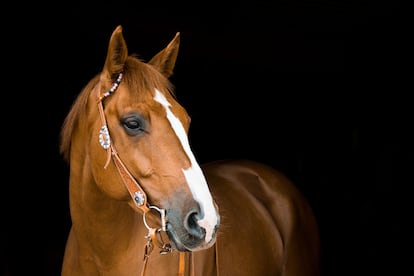Like humans, animals also have asymmetrical brains
Research on the brain lateralization of other species provides insights into their emotions

The beauty of geometry is everywhere in nature, from tiny flowers to the immensity of the solar system. Isaac Newton thought this was evidence of God’s existence, and wrote about the perfect symmetry of the human body. However important symmetry is for living things, the exceptions are equally important.
On June 15, 1865, Pierre Paul Broca presented the results of five years of research to the Society of Anthropology of Paris. As a practicing physician, Broca had analyzed the brains of several deceased patients who had suffered from speech problems throughout their lives. He found that most of them had damage to a specific area in the left frontal lobe, and concluded his lecture by famously saying, “We speak with the left hemisphere.” With that, he disrupted the scientific dogma that held that all healthy organs were symmetrical, and opened up an area of scientific research known as cerebral lateralization.
Human physical symmetry was once considered a divinely created attribute, but after Broca, the differences between our left and right brain hemispheres were held up as evidence of our superior status as a species. Broca himself argued that the asymmetry resulted from education and civilization, a consequence of having transcended a purely animal existence. Some scientists soon began saying that men’s brains were more asymmetrical than women’s brains. Back in the 17th century, René Descartes contended that the brain’s pineal gland was the seat of the human soul, but by the end of the 19th century, most believed that the brain’s left hemisphere was what made us human.
All these ideas were a reflection of the biases of the time, and lacked neurological evidence to back them up. Because language seemed to be an exclusively human characteristic, it was natural to assume that every other species had symmetrical brains. This produced the prevalent hypothesis that brain lateralization resulted from the mutation of a single gene in the Homo sapiens lineage. It took more than a century after Broca presented his discovery in Paris for science to recognize that brain asymmetry is a universal attribute in the animal kingdom.
In 1979, neuroscientist Lesley Rogers published the first paper providing definitive evidence that other animals also had cerebral lateralization. Her research subject was the chicken. Rogers observed that during the last three days of their development in the egg, chickens orient their heads so that one eye is shielded from light, while the other is exposed to light filtering through the shell. Since information entering through each eye is processed in different hemispheres, this pre-hatched head-orientation produces asymmetries in the brain. As a result, chickens use their right eyes to search for food and their left eyes to detect predators. But when eggs incubate in total darkness, no specialization in brain hemispheres takes place, so these chickens lack the ability to use their right and left eyes differently.
We now know that even a tiny nematode worm (Caenorhabditis elegans) with only 302 neurons has functional asymmetries in its nervous system. A neuron located on the left side of its body triggers the worm to move forward, while a neuron symmetrically located on the opposite side triggers the worm to change direction. The brain lateralization of bees, fruit flies and other invertebrates has also been extensively studied. In 2013, Rogers found that honeybees use their right antenna to recognize members of their own hive, which they cannot do with their left antenna.
Animals brains are less developed than ours because it’s more efficient for them in terms of energy consumption, but this does not preclude hemisphere specialization. The ubiquity of brain lateralization in animals suggests that, regardless of brain size, sharing functions between the two sides of the brain provides important adaptive advantages. For example, it provides more cognitive space for conducting additional types of processing. It also enables animals to perform simultaneous tasks, as in the example of chickens that search for food with one eye while using the other to look out for predators.
There is ample evidence that brain lateralization improves the cognitive capacity of animals. Scientists have conducted several studies to determine whether some fish (Poecilia reticulata) are good at numbers, usually by subjecting them to tests in which they have to discriminate between groups of multiple objects. Interestingly, there are significant differences in this capacity between individual fish. While some fish pass every test, others are often unsuccessful. The explanation for this diversity lies in the degree of brain lateralization of each individual. When approached by a predator, some fish will almost always turn to the right to flee, while others turn to the left. The ones that demonstrate no directional preference are also the ones that fail the numerical tests.
Emotion processing is also asymmetrical in animals. Broadly speaking, the left hemisphere tends to dominate in positive emotions and the right hemisphere in negative ones. In 2017, three researchers wanted to see if they could learn anything about a horse’s mental state by studying the leg they used to start walking. They put a carrot in a wooden box with a lid and placed it 10 meters away from the horse. The box was initially placed at an angle to the right of the horse and could be easily opened. Then it was placed at an angle to the left and was tightly closed so the horse could not retrieve the carrot. Finally, the box was placed directly ahead of the horse to see if it would approach to try and retrieve the carrot.
They repeated this procedure with 17 horses and observed which ones walked toward the box in the center. The ones that did were categorized as optimists while the ones that didn’t were categorized as pessimists. They also studied which leg each horse used to start walking, and found that the optimists used the right foreleg much more than the pessimistic ones. This is a logical result considering that the right side of the body is connected to the left hemisphere, which processes positive emotions.
There is also evidence that several domesticated animals become more frightened when they spot an unfamiliar human with their right eye than with their left eye, since information from the left eye goes to the right brain hemisphere, which specializes in processing new stimuli. So by recognizing the cerebral lateralization of animals, perhaps we can better understand their emotions and improve the quality of our relationships with them.
Sign up for our weekly newsletter to get more English-language news coverage from EL PAÍS USA Edition
Tu suscripción se está usando en otro dispositivo
¿Quieres añadir otro usuario a tu suscripción?
Si continúas leyendo en este dispositivo, no se podrá leer en el otro.
FlechaTu suscripción se está usando en otro dispositivo y solo puedes acceder a EL PAÍS desde un dispositivo a la vez.
Si quieres compartir tu cuenta, cambia tu suscripción a la modalidad Premium, así podrás añadir otro usuario. Cada uno accederá con su propia cuenta de email, lo que os permitirá personalizar vuestra experiencia en EL PAÍS.
¿Tienes una suscripción de empresa? Accede aquí para contratar más cuentas.
En el caso de no saber quién está usando tu cuenta, te recomendamos cambiar tu contraseña aquí.
Si decides continuar compartiendo tu cuenta, este mensaje se mostrará en tu dispositivo y en el de la otra persona que está usando tu cuenta de forma indefinida, afectando a tu experiencia de lectura. Puedes consultar aquí los términos y condiciones de la suscripción digital.
More information
Últimas noticias
Most viewed
- Charles Dubouloz, mountaineering star, retires at 36 with a farewell tour inspired by Walter Bonatti
- The Florida Keys tourist paradise is besieged by immigration agents: ‘We’ve never seen anything like this’
- CBS in crisis after pulling a report on Trump’s deportations to El Salvador (which later leaked online)
- Chevy Chase, the beloved comedian who was a monster off camera: ‘Not everyone hated him, just the people who’ve worked with him’
- From Gwen Stefani to Katy Perry: The MAGA drift of celebrity Democrats











































